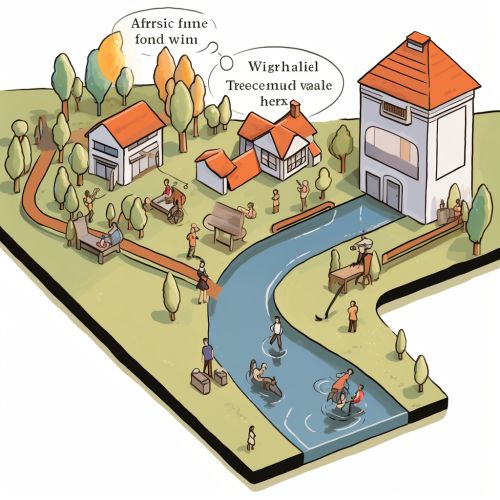Human-Computer Interaction
Introduction
Human-Computer Interaction (HCI) is a multidisciplinary field of study focusing on the design of computer technology and, in particular, the interaction between humans (the users) and computers. While initially concerned with computers, HCI has since expanded to cover almost all forms of information technology design.


History
The field of HCI was born out of the need for design and usability to come together to ensure that computer technology was not only functional but also usable. The history of HCI is closely tied to the advances in technology and the increasing ubiquity of computers in everyday life. The term itself was popularized by the seminal book "Human-Computer Interaction" by Card, Moran, and Newell in 1983 1(https://dl.acm.org/doi/book/10.5555/58015).
Theoretical Foundations
HCI draws from a wide array of disciplines such as computer science, psychology, human factors, ergonomics, and many others. The theoretical foundations of HCI lie in the cognitive and behavioral sciences, and the field is heavily research-oriented. Theories such as Activity Theory, Distributed Cognition, and Cognitive Work Analysis have been instrumental in shaping the field 2(https://www.sciencedirect.com/science/article/pii/S1071581918305039).


Key Concepts
User Interface (UI)
The User Interface is the point of interaction between the user and the computer system. It includes all the mechanisms like screens, keyboards, and mice that allow for control and feedback between the user and the system 3(https://dl.acm.org/doi/10.5555/58015).
Usability
Usability refers to the quality of a system with respect to its ease of use, efficiency, and satisfaction. It is a key concept in HCI and is often used as a benchmark for the success of a system 4(https://www.nngroup.com/articles/usability-101-introduction-to-usability/).
User Experience (UX)
User Experience is a broader concept that encompasses all aspects of the user's interaction with the system, including emotional and experiential aspects. It goes beyond mere functionality and usability to include the whole experience of using a system 5(https://www.nngroup.com/articles/definition-user-experience/).


HCI Design Principles
HCI design principles are guidelines that help to shape the interaction between users and computers. These principles are derived from a variety of sources, including psychology, ergonomics, and design theory. Some of the key principles include:
- Consistency: The design should be consistent across all elements and interfaces.
- Visibility: The design should make all necessary options and materials visible.
- Feedback: The design should provide feedback in response to user actions.
- Affordance: The design should suggest the intended functionality of an object.
- Simplicity: The design should be simple and eliminate unnecessary complexity 6(https://dl.acm.org/doi/10.5555/58015).
HCI Research Methods
Research in HCI is diverse and multidisciplinary, employing methods from computer science, psychology, and social sciences. Some common methods include:
- Observational Studies: Observing users in their natural environment to understand their interaction with technology.
- Experiments: Controlled studies to test specific hypotheses about HCI.
- Surveys and Interviews: Gathering data from users about their experiences and perceptions.
- Usability Testing: Evaluating the usability of a system by having real users complete tasks.
- Ethnography: Studying the social and cultural aspects of HCI 7(https://www.sciencedirect.com/science/article/pii/S1071581918305039).


Future of HCI
The future of HCI is likely to be shaped by advances in technology and an increasing focus on user experience. Areas such as virtual and augmented reality, artificial intelligence, and ubiquitous computing are likely to play a significant role. There is also a growing recognition of the need to consider broader social and ethical issues in HCI, such as accessibility, privacy, and digital divide 8(https://dl.acm.org/doi/10.1145/3290607.3311753).
See Also
- User Interface Design
- Usability Engineering
- Cognitive Psychology
- Information Systems
- Artificial Intelligence
References
1. Card, S., Moran, T., & Newell, A. (1983). The Psychology of Human-Computer Interaction. Lawrence Erlbaum Associates. 2. Sutcliffe, A. (2019). Designing for User Engagment: Aesthetic and Attractive User Interfaces. Synthesis Lectures on Human-Centered Informatics, 2(1), 1–55. 3. Shneiderman, B., & Plaisant, C. (2010). Designing the User Interface: Strategies for Effective Human-Computer Interaction (5th ed.). Addison-Wesley. 4. Nielsen, J. (2003). Usability 101: Introduction to Usability. Nielsen Norman Group. 5. Norman, D. (2002). The Design of Everyday Things. Basic Books. 6. Preece, J., Rogers, Y., & Sharp, H. (2015). Interaction Design: Beyond Human-Computer Interaction (4th ed.). Wiley. 7. Kuniavsky, M. (2010). Observing the User Experience: A Practitioner's Guide to User Research. Morgan Kaufmann. 8. Yee, N., & Bailenson, J. (2018). The Proteus Paradox: How Online Games and Virtual Worlds Change Us—And How They Don't. Yale University Press.
